
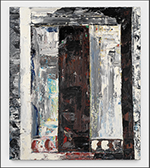
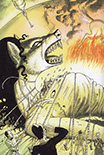
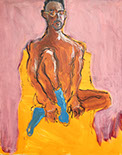
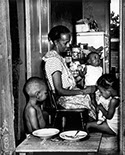
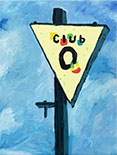

"Landlord Colors" Show Full
of Provocative Works
by K.A. Letts
Like politics, all art is local. But the most consequential art achieves universality through the particular circumstances of its creation.
In “Landlord Colors: On Art, Economy, and Materiality,” Cranbrook Art Museum curator Laura Mott, along with collaborators Taylor Renee Aldridge of the journal ARTS.BLACK and Ryan Meyers-Johnson of Sidewalk Detroit, make a convincing argument that contemporary Detroit artists who have synthesized their unique, place-specific art from the substance of a distressed city have earned membership in an exclusive club of similarly inspired artists from around the world. Specifically, Mott argues, Detroit artists, many from the Cass Corridor movement of Detroit in the ’70s, share important inspirations, material strategies and methods with artists from other cities in economic, political or social upheaval. The historic stresses and sorrows of Detroit, Athens, Turin, Seoul and Havana have made their way into the work of artists through unique materials derived from those locales. The curators have coined the term “landlord colors” (cheap and undesirable paint colors used in rental apartments) to describe the “overarching material conditions enveloping the city—a situation not of its own choosing.”
The main venue for “Landlord Colors” is the Cranbrook Art Museum, although installations and related performances extend throughout the city. It begins with a splash and a crash. The splash is provided by Cuban artist Reynier Leyva Novo, whose colorful tapestry Untitled (Immigrants) hangs at the entrance of the exhibit. The tapestry is composed of used clothing, which was donated by recently arrived Cuban refugees in Miami’s Little Havana. Novo then returned the materials to Havana, where community workers fabricated the scraps into an oversized 16’ x 16’ textile reminiscent of the welcome mats inside many Cuban homes. Nearby, an imaginary crash comes from shattering plaster in Arte Povera conceptual artist Giulio Paolini’s work L’altra figura. Paolini’s identical pair of classical plaster busts, which look down on the remains of a third, represent the artist’s reflection on the fragility of a culture under attack by domestic terrorism and at war with itself during the Years of Lead in Italy (1968-1988).
“Landlord Colors” abounds with provocative, visually satisfying pairings of works that echo and amplify each other and emphasize points of correspondence among the artists that resonate throughout the exhibition.
Addie Langford’s beautiful, post-minimalist painting BR Blue/#1 /LU features rows of inky brush strokes painted on the back of scavenged automotive interior upholstery fabric. The effect is incongruously elegant. Nearby, Umber-Blue by South Korean painter and political activist Yun Hyong-Keun makes a powerful visual argument for the ongoing influence of the South Korean Dansaekwha movement, with its formal, monochromatic aesthetic and reliance on found industrial materials.
Brenda Goodman’s three comic yet sinister figures (Self Portraits #1, #3, and #4) silently occupy the center of the first gallery. These plainly female, nearly featureless, cone-shaped apparitions are made using materials scavenged by the artist from her urban environment. Although the sculptures were completed in 1977, art history has mischievously added a layer of unintended but unmistakable meaning to the figures, as they bring to mind veiled Muslim women.
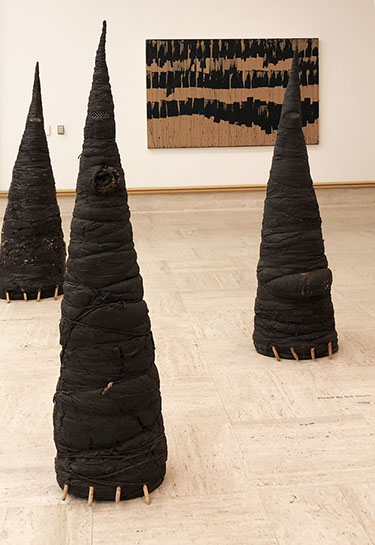
Brenda Goodman, Self Portraits #1, #3 and #,4 (foreground); Addie Langford, BR Blue/#1 /LU (background). Landlord Colors installation.
Three chairs of different provenance and intent stand at the entrance to the next gallery. They represent a continuum of material and method: the cardboard, paper, glue and wood chair recently completed by students in the Pontiac elementary schools replicates a project created 50 years earlier by Neapolitan children according to instructions from Italian architect and designer Riccardo Dalisi. More recently, Detroit designer Chris Schanck has employed the labor of his Detroit neighbors to create his Alufoil Chair. The armature of his free-form design is made of industrial materials covered with aluminum foil and then coated in resin. The adjacent chair, created by Arte Povera artist Marisa Merz, is made of aluminum. It is a fragment of the immersive installation that the artist created in the apartment she shared with her daughter and her husband, fellow artist Mario Merz.
(L to R) Riccardo Dalisi for the series Throne, Chair (1973); Chris Schanck, ALUchair (2019); Marisa Merz (from Living Sculpture) Sedia (1966). Landlord Colors installation.
After the intimacy of the chair series, the gallery around the corner opens the view with a gargantuan seascape by Cuban artist Yoan Capote. At first glance, Island (see-escape) seems fairly conventional, but then you notice that embedded in the waves are over 500,000 rusty fishhooks, Capote’s evocation of the pain of isolation on an impoverished island. In front of Island stands what might be my favorite piece of the show, Porcelain Legs in the Posture of David. Detroit artist Kylie Lockwood, a virtuoso craftsman, has cast her own feet and legs in delicately tinted porcelain, the pale sheen of her toenails contrasting with the fleshy warmth of feet and legs. The limbs rest on a plaster plinth that emerges from translucent plastic. Maybe it’s the effect of the seascape in the background, but it put me in mind less of Michelangelo’s David and more of a ruined sculptural version of Botticelli’s The Birth of Venus.
In the next gallery, Mott has cleverly paired Scott Hocking’s vintage found photo of piled-up buffalo skulls (and accompanying black-tinted bony cow cranium) with Michelangelo Pistoletto’s equally intriguing mountain of rags, half brightly colored, half white, and bisected by a mirror. It is a subtle comment on the fact that perceptions of color and whiteness depend on where you are standing.
In the adjoining gallery, Detroit artist Matthew Angelo Harrison has adapted the skills he employed as a clay prototype sculptor for Ford Motor Company by engineering his own hand-made 3D printers that, in turn, produce low resolution replicas of African historical artifacts. Thus, he neatly employs elements of the post-industrial automotive design process to comment on African cultural heritage removed from its historical context and the black American experience.
One of my favorite pairings in “Landlord Colors” is of Barbara Harris and Al Loving. Both artists are native Detroiters, but Loving departed for New York in 1968, where he made his name as a painter of hard-edged geometry. His rejection of that aesthetic in the early ’70s with the work shown here—unstretched, pieced and dyed canvas—is in fruitful dialog with Barbara Harris’s recent fiber work. Harris’s In a Silent Way combines the syntax of African American quilt-making with her unique staining, rusting, burning process to create a visually and spiritually satisfying distillation of black urban experience.
It would be tempting to merely recite the names and descriptions of all the remarkable artists in “Landlord Colors,” both from Detroit and elsewhere, but space doesn’t permit that sort of exposition. Important Detroit artists like Gilda Snowden, Allie McGhee, Tiff Massey, Tyree Guyton, Michael Luchs and Charles McGee are represented here, and if the work shown isn’t necessarily representative of the broad substance of their output, it does name-check them for further investigation. Most importantly, through careful editing and thoughtful installation, Mott and her fellow curators have created a convincing narrative that places Detroit artists within the context of a global movement of transcendent art created from extreme hardship.
And “Landlord Colors” doesn’t stop at the walls of Cranbrook Art Museum. “Material Detroit,” an extended citywide series of performances, conversations and installations, expands and amplifies the themes in the Cranbrook exhibit. The offsite offerings will continue through October of 2019.
I have not seen all of the performances, and some of them will not have occurred before this review goes to press. But I will mention a couple of the most remarkable offerings here. Scott Hocking’s Bone Black, an installation near Detroit’s waterfront, is a dreamlike vision of discarded boats that seem to float, suspended, from the ceiling of an abandoned warehouse, ghosts of Detroit’s once prosperous economy. Iron Teaching Rocks How to Rust by Olayami Dabls is an outdoor installation located near his iconic MBad Bead Museum. The Bead Museum also features a new, intimate gallery where the elegant textiles, drawings and ceramics of Elizabeth Youngblood are on view. Near Eastern Market, Anders Ruhwald, creator of monumental ceramics and installation artist, has created an uncanny environment of charred wood, black vessels, vertiginous rooms and overlooks in his installation Unit 1: 3583 Dubois.
“Landlord Colors” is an ambitious effort to place Detroit’s artists in a global context through their shared use of material, and in this, the curators have succeeded. However, it should be acknowledged that in motivation, outlook, and ideology, the artists featured in “Landlord Colors” are as different as they are the same.
The Dansaekwha artists show a particularly satisfying visual relationship with the post-minimalist paintings chosen for the exhibit, but one could argue that artists in post-World War II South Korea viewed their work as a rejection of the formal constrictions of traditional Asian art and a turning toward Western values, rather than as a critique of political repression, racism, materialism or any other Western -ism as addressed by Detroit’s artists. And while Detroit artists adapted the detritus of a post-industrial manufacturing milieu to their own purposes by necessity, Italian artists of the Arte Povera movement chose to employ non-traditional materials as a rejection of tired, traditional European assumptions about art production. The most persuasive correspondences overall, it seems to me, are between the Cuban artists and artists from Detroit, who share preoccupations with race, social isolation and poverty
The disasters and catastrophes which have afflicted the countries represented in "Landlord Colors" are varied: political repression (on both the left and right), economic collapse, domestic terrorism, and racism. What remains constant is the resilience and creativity of the artists in each environment. They acknowledge their trying circumstances even as they rise above them, employing the materials at hand to make art that speaks to a global audience.
"Landlord Colors" is on view from June 22 to October 6, 2019 at the Cranbrook Art Museum.
K.A. Letts is a working artist (kalettsart.com) and art blogger (rustbeltarts.com). She has shown her paintings and drawings in galleries and museums in Toledo, Detroit, Chicago and New York. She writes frequently about art in the Detroit area.
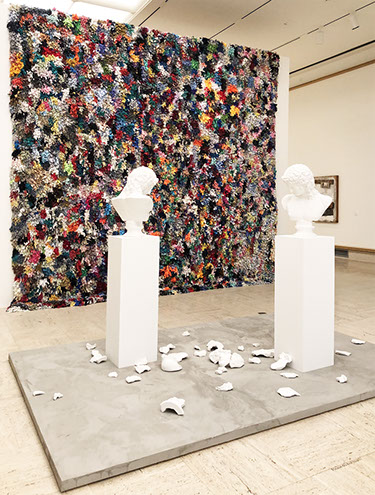
Giulio Paolini, L’altra figura (foreground); Reynier Leyva Novo, Untitled (Immigrants) (background). Landlord Colors installation.
